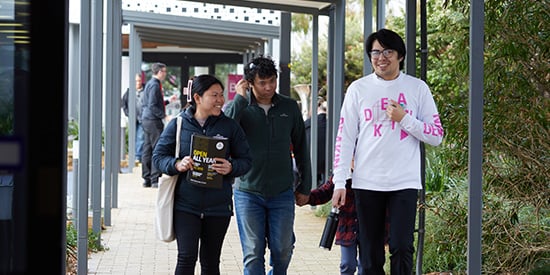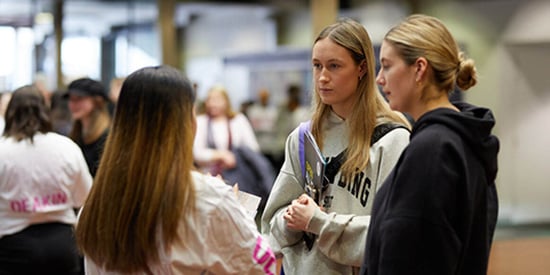Key facts
Duration
This course is 1 year full-time or part-time equivalent duration
Locations
Key dates
Direct applications to Deakin for Trimester 2 2024 close 23 June 2024
Current Deakin Students
To access your official course details for the year you started your degree, please visit the handbook
Course overview
The Graduate Diploma in Visual Communication Design provides practical and theoretical skills in Visual Communication Design. This is achieved through a combination of study incorporating the contemporary thinking and techniques required for professional design practice. The course explores design's role as an agent of change and as a key link between creativity and innovation. It also addresses the social, cultural and ethical implications of design practice as well as in-depth studies of new technology in design with an emphasis on typography, form and application. Historical and contemporary graphic design processes are explored within both local and international contexts.
The Graduate Diploma in Visual Communication Design encourages you to shape your ideas into practical and attractive propositions for users, customers and society as a whole. It offers a solid foundation for employment in the communication design industry or continued study in the field.
Read MoreCourse information
- Award granted
- Graduate Diploma of Visual Communication Design
- Year
2024 course information
- Deakin code
- A638
- Level
- Postgraduate (Graduate Certificate and Graduate Diploma)
- Australian Qualifications Framework (AQF) recognition
The award conferred upon completion is recognised in the Australian Qualifications Framework at Level 8.
Course structure
To qualify for the award of Graduate Diploma of Visual Communication Design, students must successfully complete:
- 6 credit points in Visual Communication Design from the units listed below, plus
- 2 credit points of electives
- Academic Integrity Module DAI001 (0-credit-point compulsory unit)
6
Visual communication design units
2
Elective units
8
Total
Core Units
Electives
Electives may be chosen from the remaining units above or from any other postgraduate course in the School of Communication and Creative Arts. Students who intend to move from the Graduate Diploma to the Master of Communication are strongly advised to take ACX701 Communication Concepts for their two elective credit points.
Intakes by location
The availability of a course varies across locations and intakes. This means that a course offered in Trimester 1 may not be offered in the same location for Trimester 2 or 3. Check each intake for up-to-date information on when and where you can commence your studies.
Trimester 1 - March
- Start date: March
- Available at:
- Burwood (Melbourne)
- Online
Trimester 2 - July
- Start date: July
- Available at:
- Burwood (Melbourne)
- Online
Additional course information
Course duration
Course duration may be affected by delays in completing course requirements, such as accessing or completing work placements.
Mandatory student checks
Any unit which contains work integrated learning, a community placement or interaction with the community may require a police check, Working with Children Check or other check.
Participation requirements
Reasonable adjustments to participation and other course requirements will be made for students with a disability. More information available at Disability support services.
Work experience
Elective units may provide the opportunity for Work Integrated Learning experiences.
Need help?
Ask a question about studying at Deakin
Entry requirements
Selection is based on a holistic consideration of your academic merit, work experience, likelihood of success, availability of places, participation requirements, regulatory requirements, and individual circumstances. You will need to meet the minimum academic and English language proficiency requirements to be considered for selection, but this does not guarantee admission.
Academic requirements
To be considered for admission to this degree you will need to meet at least one of the following criteria:
- completion of a bachelor degree or higher
- at least two years' relevant work experience (or part-time equivalent)
English language proficiency requirements
To meet the English language proficiency requirements of this course, you will need to demonstrate at least one of the following:
- bachelor degree from a recognised English-speaking country
- IELTS overall score of 6.5 (with no band score less than 6.0) or equivalent
- other evidence of English language proficiency (learn more about other ways to satisfy the requirements)
Admissions information
Learn more about Deakin courses and how we compare to other universities when it comes to the quality of our teaching and learning.
Not sure if you can get into Deakin postgraduate study? Postgraduate study doesn’t have to be a balancing act; we provide flexible course entry and exit options based on your desired career outcomes and the time you are able to commit to your study.
Recognition of prior learning
The University aims to provide students with as much credit as possible for approved prior study or informal learning which exceeds the normal entrance requirements for the course and is within the constraints of the course regulations. Students are required to complete a minimum of one-third of the course at Deakin University, or four credit points, whichever is the greater. In the case of certificates, including graduate certificates, a minimum of two credit points within the course must be completed at Deakin.
You can also refer to the Recognition of prior learning system which outlines the credit that may be granted towards a Deakin University degree and how to apply for credit.
Fees and scholarships
Fee information
Learn more about fees and your options for paying.
The available fee places for this course are detailed above. Not all courses at Deakin have Commonwealth supported places available.
The 'Estimated tuition fee' is provided as a guide only based on a typical enrolment of students completing this course within the same year. The cost will vary depending on the units you choose, your study load, the length of your course and any approved Recognition of prior learning.
One year full-time study load is typically represented by eight credit points of study. Each unit you enrol in has a credit point value. The 'Estimated tuition fee' is calculated by adding together eight credit points of a typical combination of units for your course.
You can find the credit point value of each unit under the Unit Description by searching for the unit in the Handbook.
Learn more about fees and available payment options.
FEE-HELP calculator
What is FEE-HELP?
FEE-HELP loans cover up to 100% of tuition fees for eligible students. By taking out a FEE-HELP loan, the government pays your tuition fees directly to Deakin, and the balance is repaid from your employment income - but only once you're earning over $51,550.
Please note: fees shown by the calculator are indicative only and based on 2024 rates. Actual fees may vary. We advise confirming fees with Prospective Student Enquiries prior to enrolment.
Estimate your FEE-HELP
FEE-HELP payments
per pay cycle
Take-home pay
after FEE-HELP and tax
per pay cycle
Your estimated FEE-HELP repayments
- $* is the estimated full cost for a Graduate Diploma of Visual Communication Design (8 credit points), based on the 2024 fees.
- is the annual FEE-HELP payment, based on your current salary
- of your current salary be spent on FEE-HELP
*Disclaimer
Deakin University (Deakin):
- gives no warranty and accepts no responsibility for the currency, accuracy or the completeness of the information provided;
- advises users that no reliance should be placed upon on the information provided, and;
- instructs users that they should confirm the actual course fee with Prospective Student Enquiries prior to enrolment.
This tool provides indicative information about the fees that will be payable in respect of courses and subjects offered to prospective students domiciled in Australia during the periods indicated.
Please note that the fees shown by the calculator are indicative only and actual fees may vary. Users are advised to confirm the actual course fee with Prospective Student Enquiries prior to enrolment.
The estimated course fee is based on the tuition fee costs applicable to a domestic full time student commencing the course in Trimester 1 and studying full time for the duration of the course but:
- does not include non-tuition costs that may apply, such as Student Services and Amenities Fees (SSAF);
- does not take into account any scholarships or bursaries awarded to the student (including the 10% Deakin alumni discount);
- assumes the maximum number of units that need to be successfully completed actual number completed may be reduced if recognition of prior learning is granted;
- assumes that no exceptional, or non-typical, circumstances apply to the proposed course of study;
- assumes that the options that the user selects are appropriate for the course of study that they intend to undertake;
- where fees are estimated for future years those fee will be subject to annual increases in accordance with increases in the cost of course delivery.
Scholarship options
A Deakin scholarship might change your life. If you've got something special to offer Deakin – or you just need the financial help to get you here – we may have a scholarship opportunity for you.
Postgraduate bursary
If you’re a Deakin alumnus commencing a postgraduate award course, you may be eligible to receive a 10% reduction per unit on your enrolment fees.
Apply now
Some of our courses have limited places available - for the latest on courses still open for application, visit Courses by trimester.
Create an account in the Deakin Application Portal, start your application, enter personal details, education experience, upload supporting documents and submit. Need help? Play this video, or contact one of our friendly future student advisers on 1800 693 888 or submit an online enquiry.
For more information on the application process and closing dates, see the How to apply webpage. If you're still having problems, please contact us for assistance.
Entry pathways
Alternative exits
Contact information
Our friendly advisers are available to speak to you one-on-one about your study options, support services and how we can help you further your career.
- Call us: 1800 693 888 Mon–Fri, 9am–5pm
- Live Chat: Mon–Thurs, 8am–7pm, Fri 8am–5pm
- Submit an online enquiry
- Help hub find common and trending questions and answers
Careers
Career outcomes
As a graduate of Deakin's Graduate Diploma of Visual Communication Design you will be able to communicate and produce industry and audience-relevant solutions to communication problems and opportunities which require visual design in the strategy mix. In addition, the course will develop graduates with sound theoretical grounding in cultural, business and professional skills to enable them to be effective practitioners.
Graduates are likely to find work in areas such as advertising and marketing communication, communication strategy, corporate branding, design consultancies or creative boutiques. Graduates may be employed, work on a freelance basis or be self-employed. With a focus on both communication design knowledge and technical skills, graduates are better prepared for the rapidly evolving, ever-changing communication industries.
For more information go to DeakinTALENT
Course learning outcomes
Deakin's graduate learning outcomes describe the knowledge and capabilities graduates can demonstrate at the completion of their course. These outcomes mean that regardless of the Deakin course you undertake, you can rest assured your degree will teach you the skills and professional attributes that employers value. They'll set you up to learn and work effectively in the future.
| Deakin Graduate Learning Outcomes | Course Learning Outcomes |
| Discipline-specific knowledge and capabilities | Apply specialised knowledge in order to research, plan, and produce design-based solutions to complex visual communication challenges, drawing on advanced knowledge and skills to analyse communication design as applied in a local, national, and international context. |
| Communication | Utilise communication skills to transmit visual communication design ideas, analyses, findings, and strategies through advanced written and oral presentation. |
| Digital literacy | Employ a range of specialist skills using industry standard design programs and other digital literacies to source, analyse, generate and disseminate design solutions to an advanced level. |
| Critical thinking | Critically evaluate contemporary design practices, design conversations, and design issues, and apply them in professional design practice taking into account ethical and legal issues surrounding visual communication. |
| Problem solving | Employ specialised knowledge, skills and creativity supported by research-based theoretical underpinnings to generate advanced design solutions to complex visual communication design briefs. |
| Self-management | Exercise initiative and autonomy in planning, decision-making and problem solving in the field of visual communication design. |
| Teamwork | Work and learn collaboratively, collegially, and responsibly with a range of disciplines, clients and industry representatives in the field of visual communication design. |
| Global citizenship | Work responsibly in the context of global, economic and ethical influences on the practice of visual communication design taking into consideration cultural and socio-economic diversity, social and environmental responsibility and the application of the highest ethical standards. |
| Approved by Faculty Board November 2022 | |




